Marketing Principles Report: Aldi's Strategies and Analysis
VerifiedAdded on 2019/12/28
|15
|4013
|132
Report
AI Summary
This report provides a comprehensive analysis of Aldi's marketing principles, examining various aspects of its marketing strategies. The report begins with an introduction to marketing and its core principles, followed by an analysis of Aldi's marketing process, including situation analysis, strategy development, marketing mix decisions, and implementation. It then delves into the benefits and costs of marketing orientation, micro and macro environmental factors, and market segmentation criteria. The report also explores Aldi's target strategy, the effects of buying behavior on marketing activities, and proposed positioning strategies. Furthermore, it examines how Aldi develops products and services to sustain a competitive advantage, optimizes distribution, reflects pricing strategies, integrates promotional activities, and analyzes the extended marketing mix. The report also includes a comparison of marketing mixes for different market segments, a discussion of the differences between B2B and B2C marketing, and a comparison of international and domestic marketing strategies, concluding with a summary of key findings and recommendations.
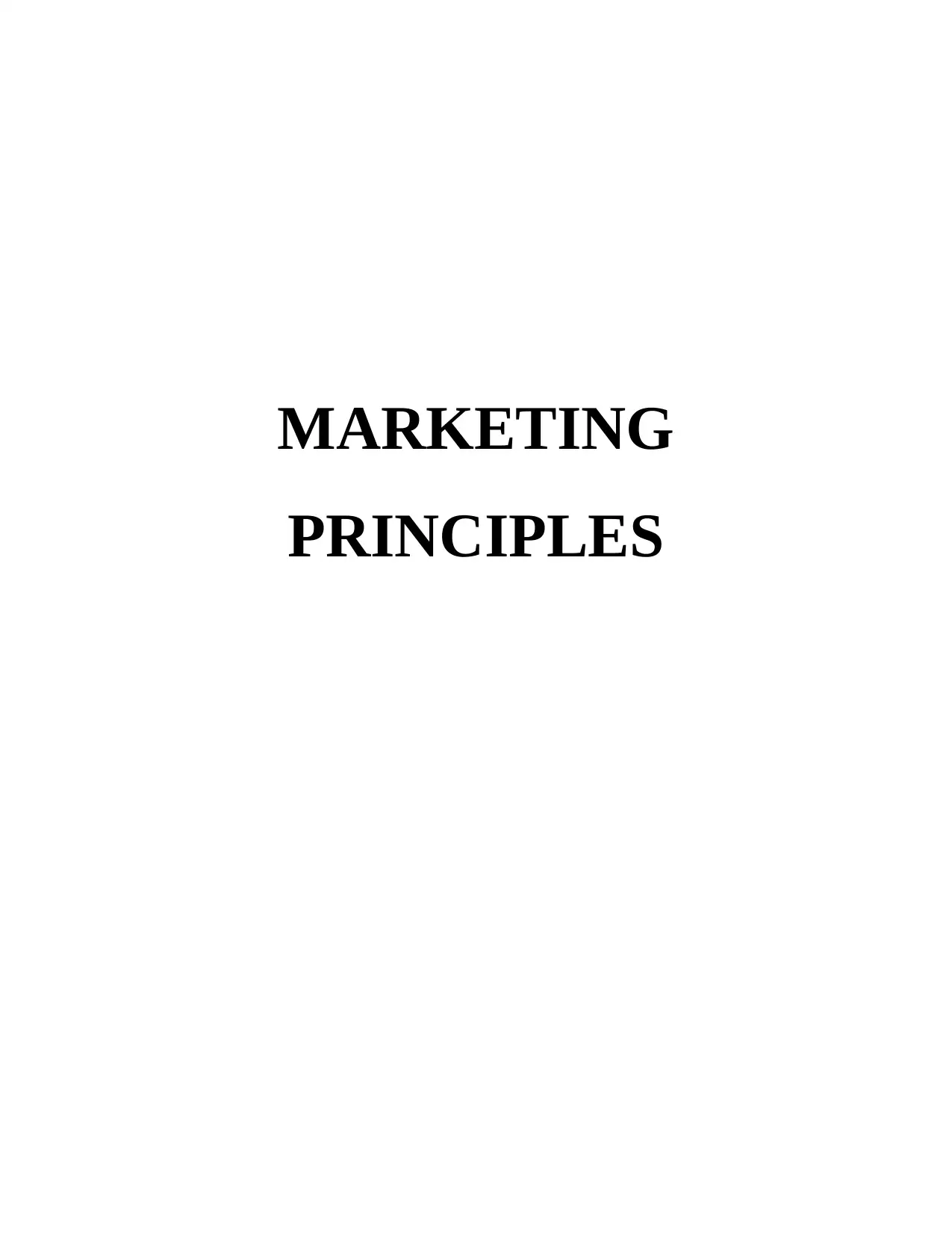
MARKETING
PRINCIPLES
PRINCIPLES
Paraphrase This Document
Need a fresh take? Get an instant paraphrase of this document with our AI Paraphraser

Table of Contents
INTRODUCTION...........................................................................................................................1
TASK 1............................................................................................................................................1
AC 1.1 Elements of Marketing Process......................................................................................1
AC 1.2 Benefits and costs of marketing orientation...................................................................2
AC 2.1 Macro and micro environmental factors with appropriate tools and techniques............3
AC 2.2 Criteria for market segmentation....................................................................................4
AC 2.3 Target strategy for selected product/service ..................................................................5
AC 2.4 Effects of buying behaviour on marketing activities......................................................6
AC 2.5 Propose new positioning strategy...................................................................................6
AC 3.1 Products/services developed to sustain competitive advantage.....................................7
AC 3.2 Arrangement of distribution for better convenience.......................................................7
AC 3.3 Reflection of pricing on company's objectives and market condition............................7
AC 3.4 Integration of promotional activity to achieve marketing objectives.............................8
AC 3.5 Analyse the additional elements of extended marketing mix.........................................8
TASK 2............................................................................................................................................9
AC 4.1 Marketing mix for two different market segment..........................................................9
AC 4.2 Difference between B2B and B2C.................................................................................9
AC 4.3 Difference between International marketing and Domestic marketing and
implementation of marketing strategy in abroad.....................................................................10
CONCLUSION .............................................................................................................................11
REFERENCES .............................................................................................................................12
INTRODUCTION...........................................................................................................................1
TASK 1............................................................................................................................................1
AC 1.1 Elements of Marketing Process......................................................................................1
AC 1.2 Benefits and costs of marketing orientation...................................................................2
AC 2.1 Macro and micro environmental factors with appropriate tools and techniques............3
AC 2.2 Criteria for market segmentation....................................................................................4
AC 2.3 Target strategy for selected product/service ..................................................................5
AC 2.4 Effects of buying behaviour on marketing activities......................................................6
AC 2.5 Propose new positioning strategy...................................................................................6
AC 3.1 Products/services developed to sustain competitive advantage.....................................7
AC 3.2 Arrangement of distribution for better convenience.......................................................7
AC 3.3 Reflection of pricing on company's objectives and market condition............................7
AC 3.4 Integration of promotional activity to achieve marketing objectives.............................8
AC 3.5 Analyse the additional elements of extended marketing mix.........................................8
TASK 2............................................................................................................................................9
AC 4.1 Marketing mix for two different market segment..........................................................9
AC 4.2 Difference between B2B and B2C.................................................................................9
AC 4.3 Difference between International marketing and Domestic marketing and
implementation of marketing strategy in abroad.....................................................................10
CONCLUSION .............................................................................................................................11
REFERENCES .............................................................................................................................12

INTRODUCTION
Marketing is the process of identifying needs and wants of customer and fulfil them
by giving best solution in form of products and services. And also aware them about these
solution through which they can satisfy their needs and wants. For doing marketing an
organization has to follow its principles for achieving objectives. The report is going to
answer the principles of marketing and it is based on “Aldi” company. It is retail company
in private sector. The report is throwing light on the marketing process, benefits and cost
of marketing, micro & macro factors of marketing, competitive advantage, distribution
channel, effect of marketing condition on the company and promotional strategies. The
marketing mix with different segments of market and its impact has disclosed under. The
difference between products and services for the businesses have covered. Differentiation
of international marketing and domestic marketing and how a business can develop its
marketing strategy to approach in abroad.
TASK 1
AC 1.1 Elements of Marketing Process
Every company has to follow the process of marketing to getting the correct
information. There are four elements of marketing process which has given below:
1
Marketing is the process of identifying needs and wants of customer and fulfil them
by giving best solution in form of products and services. And also aware them about these
solution through which they can satisfy their needs and wants. For doing marketing an
organization has to follow its principles for achieving objectives. The report is going to
answer the principles of marketing and it is based on “Aldi” company. It is retail company
in private sector. The report is throwing light on the marketing process, benefits and cost
of marketing, micro & macro factors of marketing, competitive advantage, distribution
channel, effect of marketing condition on the company and promotional strategies. The
marketing mix with different segments of market and its impact has disclosed under. The
difference between products and services for the businesses have covered. Differentiation
of international marketing and domestic marketing and how a business can develop its
marketing strategy to approach in abroad.
TASK 1
AC 1.1 Elements of Marketing Process
Every company has to follow the process of marketing to getting the correct
information. There are four elements of marketing process which has given below:
1
⊘ This is a preview!⊘
Do you want full access?
Subscribe today to unlock all pages.

Trusted by 1+ million students worldwide

Situation analysis – Initially marketing manager has to analyse the entire situation.
And this is done with the help of SWOT analysis. This identifies the organization's
strengths, weaknesses, opportunities and threats(Acharya, Mahat and
Mithulananthan, 2006). The evaluation of situation helps the manager to understand
the resources they can build on and the challenges which they have to face. Aldi
does the same, analyse the situation and then react accordingly. This helps in taking
decisions related to marketing planning.
Marketing strategy – After analysing the situation internally and externally, then
the management builds required marketing strategy which fulfils the demand of
customers. The preparation of developing strategies must be according to the
market condition then only company can earn profits otherwise it will prove failure.
Marketing mix decision – When required marketing strategy has build then
company has to decide what will be the marketing mix. This includes 4 P's which
are: Product, Place, Price and Promotion. These are the elements which helps in
taking appropriate decisions regarding the company's products and services.
Implementation and control – After taking all the required decisions then time for
execution has come. This is the most important step of marketing process. All has
depended on the implementation part(Ailawadi, Lehmann and Neslin, 2001). If it
goes wrong then the whole planning will be the waste of time and company has to
bear the loss.
AC 1.2 Benefits and costs of marketing orientation
Several benefits and costs have associated with the orientation of marketing. And
these help Aldi to take decisions regarding future plans. Though marketing orientation is
having costs but it is also beneficial. Some of them are as follows:
Benefits of marketing orientation
Through marketing organization can gather information about the needs, wants and
desires of customers.
This provides information about the current market share of 'Aldi'. Because it gives
impact on the perception of stakeholders and investors.
2
And this is done with the help of SWOT analysis. This identifies the organization's
strengths, weaknesses, opportunities and threats(Acharya, Mahat and
Mithulananthan, 2006). The evaluation of situation helps the manager to understand
the resources they can build on and the challenges which they have to face. Aldi
does the same, analyse the situation and then react accordingly. This helps in taking
decisions related to marketing planning.
Marketing strategy – After analysing the situation internally and externally, then
the management builds required marketing strategy which fulfils the demand of
customers. The preparation of developing strategies must be according to the
market condition then only company can earn profits otherwise it will prove failure.
Marketing mix decision – When required marketing strategy has build then
company has to decide what will be the marketing mix. This includes 4 P's which
are: Product, Place, Price and Promotion. These are the elements which helps in
taking appropriate decisions regarding the company's products and services.
Implementation and control – After taking all the required decisions then time for
execution has come. This is the most important step of marketing process. All has
depended on the implementation part(Ailawadi, Lehmann and Neslin, 2001). If it
goes wrong then the whole planning will be the waste of time and company has to
bear the loss.
AC 1.2 Benefits and costs of marketing orientation
Several benefits and costs have associated with the orientation of marketing. And
these help Aldi to take decisions regarding future plans. Though marketing orientation is
having costs but it is also beneficial. Some of them are as follows:
Benefits of marketing orientation
Through marketing organization can gather information about the needs, wants and
desires of customers.
This provides information about the current market share of 'Aldi'. Because it gives
impact on the perception of stakeholders and investors.
2
Paraphrase This Document
Need a fresh take? Get an instant paraphrase of this document with our AI Paraphraser

It makes better understanding of shift of customers from the stages of the
communication effect.
Helps in knowing the perception of customers toward products and make
improvements accordingly.
The packaging and labelling of the products attract the customer.
Costs of marketing orientation
Costs of promotion-
1. Advertising cost-: All the costs which occur on the advertisement of the product are
to be included here. Like cost of advertisement agency, appointed officer etc.
2. Sales promotion cost-: This cost includes consumer promotion cost, trade
promotion cost and business and sales force promotion cost(Andreasen and Kotler,
2008). The selling and distribution expenses are also covered under this cost.
3. Public relations-: The cost which is related to the marketing research, designing,
labelling, packaging, outsourcing and discounts given to distributors are to be
involved into this.
AC 2.1 Macro and micro environmental factors with appropriate tools and techniques
Various factors of micro and macro environment which affects the marketing
decisions of the organization like Aldi.
Micro environmental factors – The factors which affects the micro environment of Aldi
are as given below: Customers – The ultimate objective of Aldi is to satisfy the needs and wants of
customer with the best possible manner(Coiacetto, 2007). Then the decisions
regarding marketing put more efforts in knowing the preference, habits and taste of
customers. Employees – These are the internal element of Aldi company. The satisfaction level
of employees affect the overall performance. If they are efficient the resultant
outcome is also good enough.
3
communication effect.
Helps in knowing the perception of customers toward products and make
improvements accordingly.
The packaging and labelling of the products attract the customer.
Costs of marketing orientation
Costs of promotion-
1. Advertising cost-: All the costs which occur on the advertisement of the product are
to be included here. Like cost of advertisement agency, appointed officer etc.
2. Sales promotion cost-: This cost includes consumer promotion cost, trade
promotion cost and business and sales force promotion cost(Andreasen and Kotler,
2008). The selling and distribution expenses are also covered under this cost.
3. Public relations-: The cost which is related to the marketing research, designing,
labelling, packaging, outsourcing and discounts given to distributors are to be
involved into this.
AC 2.1 Macro and micro environmental factors with appropriate tools and techniques
Various factors of micro and macro environment which affects the marketing
decisions of the organization like Aldi.
Micro environmental factors – The factors which affects the micro environment of Aldi
are as given below: Customers – The ultimate objective of Aldi is to satisfy the needs and wants of
customer with the best possible manner(Coiacetto, 2007). Then the decisions
regarding marketing put more efforts in knowing the preference, habits and taste of
customers. Employees – These are the internal element of Aldi company. The satisfaction level
of employees affect the overall performance. If they are efficient the resultant
outcome is also good enough.
3
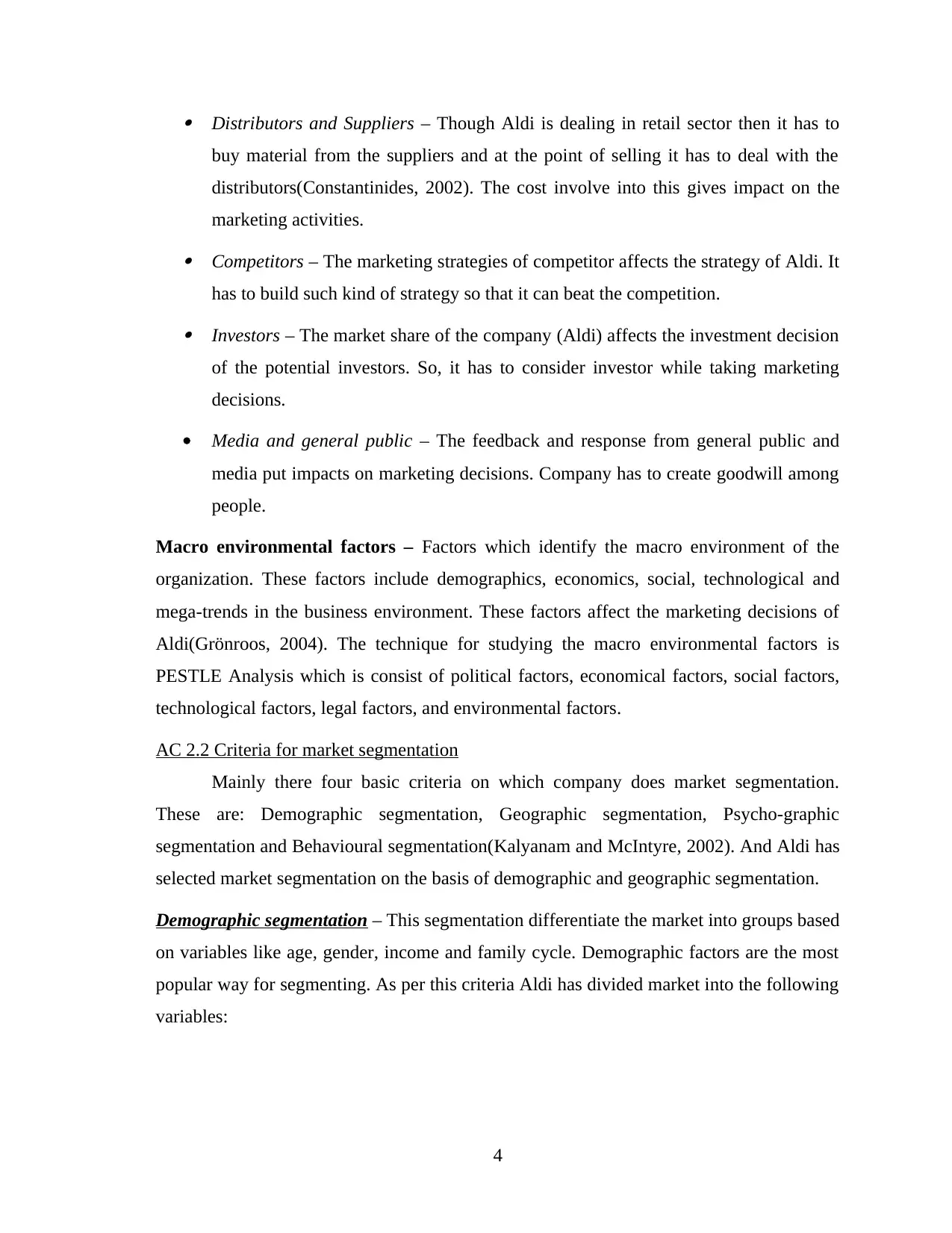
Distributors and Suppliers – Though Aldi is dealing in retail sector then it has to
buy material from the suppliers and at the point of selling it has to deal with the
distributors(Constantinides, 2002). The cost involve into this gives impact on the
marketing activities. Competitors – The marketing strategies of competitor affects the strategy of Aldi. It
has to build such kind of strategy so that it can beat the competition. Investors – The market share of the company (Aldi) affects the investment decision
of the potential investors. So, it has to consider investor while taking marketing
decisions.
Media and general public – The feedback and response from general public and
media put impacts on marketing decisions. Company has to create goodwill among
people.
Macro environmental factors – Factors which identify the macro environment of the
organization. These factors include demographics, economics, social, technological and
mega-trends in the business environment. These factors affect the marketing decisions of
Aldi(Grönroos, 2004). The technique for studying the macro environmental factors is
PESTLE Analysis which is consist of political factors, economical factors, social factors,
technological factors, legal factors, and environmental factors.
AC 2.2 Criteria for market segmentation
Mainly there four basic criteria on which company does market segmentation.
These are: Demographic segmentation, Geographic segmentation, Psycho-graphic
segmentation and Behavioural segmentation(Kalyanam and McIntyre, 2002). And Aldi has
selected market segmentation on the basis of demographic and geographic segmentation.
Demographic segmentation – This segmentation differentiate the market into groups based
on variables like age, gender, income and family cycle. Demographic factors are the most
popular way for segmenting. As per this criteria Aldi has divided market into the following
variables:
4
buy material from the suppliers and at the point of selling it has to deal with the
distributors(Constantinides, 2002). The cost involve into this gives impact on the
marketing activities. Competitors – The marketing strategies of competitor affects the strategy of Aldi. It
has to build such kind of strategy so that it can beat the competition. Investors – The market share of the company (Aldi) affects the investment decision
of the potential investors. So, it has to consider investor while taking marketing
decisions.
Media and general public – The feedback and response from general public and
media put impacts on marketing decisions. Company has to create goodwill among
people.
Macro environmental factors – Factors which identify the macro environment of the
organization. These factors include demographics, economics, social, technological and
mega-trends in the business environment. These factors affect the marketing decisions of
Aldi(Grönroos, 2004). The technique for studying the macro environmental factors is
PESTLE Analysis which is consist of political factors, economical factors, social factors,
technological factors, legal factors, and environmental factors.
AC 2.2 Criteria for market segmentation
Mainly there four basic criteria on which company does market segmentation.
These are: Demographic segmentation, Geographic segmentation, Psycho-graphic
segmentation and Behavioural segmentation(Kalyanam and McIntyre, 2002). And Aldi has
selected market segmentation on the basis of demographic and geographic segmentation.
Demographic segmentation – This segmentation differentiate the market into groups based
on variables like age, gender, income and family cycle. Demographic factors are the most
popular way for segmenting. As per this criteria Aldi has divided market into the following
variables:
4
⊘ This is a preview!⊘
Do you want full access?
Subscribe today to unlock all pages.

Trusted by 1+ million students worldwide
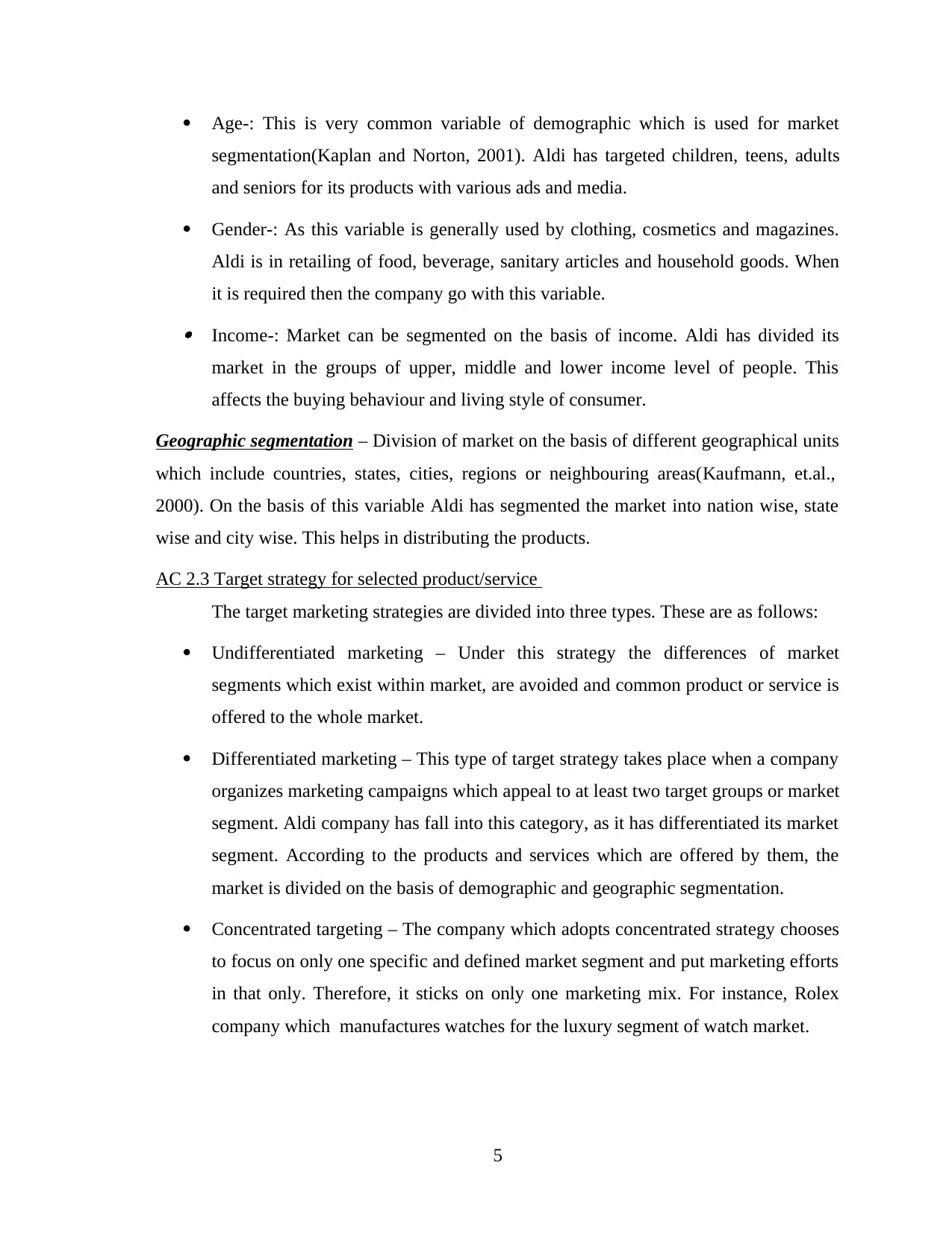
Age-: This is very common variable of demographic which is used for market
segmentation(Kaplan and Norton, 2001). Aldi has targeted children, teens, adults
and seniors for its products with various ads and media.
Gender-: As this variable is generally used by clothing, cosmetics and magazines.
Aldi is in retailing of food, beverage, sanitary articles and household goods. When
it is required then the company go with this variable. Income-: Market can be segmented on the basis of income. Aldi has divided its
market in the groups of upper, middle and lower income level of people. This
affects the buying behaviour and living style of consumer.
Geographic segmentation – Division of market on the basis of different geographical units
which include countries, states, cities, regions or neighbouring areas(Kaufmann, et.al.,
2000). On the basis of this variable Aldi has segmented the market into nation wise, state
wise and city wise. This helps in distributing the products.
AC 2.3 Target strategy for selected product/service
The target marketing strategies are divided into three types. These are as follows:
Undifferentiated marketing – Under this strategy the differences of market
segments which exist within market, are avoided and common product or service is
offered to the whole market.
Differentiated marketing – This type of target strategy takes place when a company
organizes marketing campaigns which appeal to at least two target groups or market
segment. Aldi company has fall into this category, as it has differentiated its market
segment. According to the products and services which are offered by them, the
market is divided on the basis of demographic and geographic segmentation.
Concentrated targeting – The company which adopts concentrated strategy chooses
to focus on only one specific and defined market segment and put marketing efforts
in that only. Therefore, it sticks on only one marketing mix. For instance, Rolex
company which manufactures watches for the luxury segment of watch market.
5
segmentation(Kaplan and Norton, 2001). Aldi has targeted children, teens, adults
and seniors for its products with various ads and media.
Gender-: As this variable is generally used by clothing, cosmetics and magazines.
Aldi is in retailing of food, beverage, sanitary articles and household goods. When
it is required then the company go with this variable. Income-: Market can be segmented on the basis of income. Aldi has divided its
market in the groups of upper, middle and lower income level of people. This
affects the buying behaviour and living style of consumer.
Geographic segmentation – Division of market on the basis of different geographical units
which include countries, states, cities, regions or neighbouring areas(Kaufmann, et.al.,
2000). On the basis of this variable Aldi has segmented the market into nation wise, state
wise and city wise. This helps in distributing the products.
AC 2.3 Target strategy for selected product/service
The target marketing strategies are divided into three types. These are as follows:
Undifferentiated marketing – Under this strategy the differences of market
segments which exist within market, are avoided and common product or service is
offered to the whole market.
Differentiated marketing – This type of target strategy takes place when a company
organizes marketing campaigns which appeal to at least two target groups or market
segment. Aldi company has fall into this category, as it has differentiated its market
segment. According to the products and services which are offered by them, the
market is divided on the basis of demographic and geographic segmentation.
Concentrated targeting – The company which adopts concentrated strategy chooses
to focus on only one specific and defined market segment and put marketing efforts
in that only. Therefore, it sticks on only one marketing mix. For instance, Rolex
company which manufactures watches for the luxury segment of watch market.
5
Paraphrase This Document
Need a fresh take? Get an instant paraphrase of this document with our AI Paraphraser
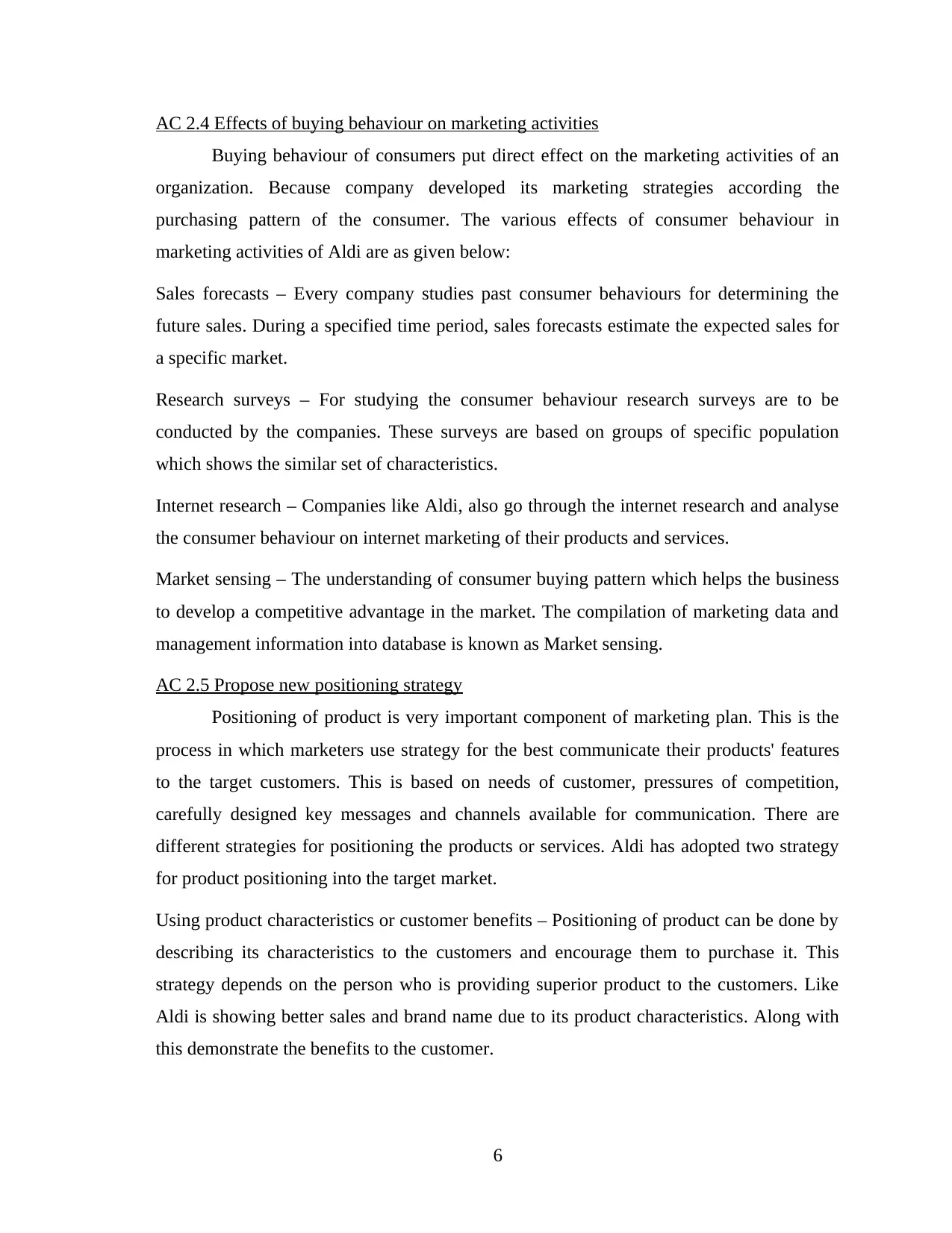
AC 2.4 Effects of buying behaviour on marketing activities
Buying behaviour of consumers put direct effect on the marketing activities of an
organization. Because company developed its marketing strategies according the
purchasing pattern of the consumer. The various effects of consumer behaviour in
marketing activities of Aldi are as given below:
Sales forecasts – Every company studies past consumer behaviours for determining the
future sales. During a specified time period, sales forecasts estimate the expected sales for
a specific market.
Research surveys – For studying the consumer behaviour research surveys are to be
conducted by the companies. These surveys are based on groups of specific population
which shows the similar set of characteristics.
Internet research – Companies like Aldi, also go through the internet research and analyse
the consumer behaviour on internet marketing of their products and services.
Market sensing – The understanding of consumer buying pattern which helps the business
to develop a competitive advantage in the market. The compilation of marketing data and
management information into database is known as Market sensing.
AC 2.5 Propose new positioning strategy
Positioning of product is very important component of marketing plan. This is the
process in which marketers use strategy for the best communicate their products' features
to the target customers. This is based on needs of customer, pressures of competition,
carefully designed key messages and channels available for communication. There are
different strategies for positioning the products or services. Aldi has adopted two strategy
for product positioning into the target market.
Using product characteristics or customer benefits – Positioning of product can be done by
describing its characteristics to the customers and encourage them to purchase it. This
strategy depends on the person who is providing superior product to the customers. Like
Aldi is showing better sales and brand name due to its product characteristics. Along with
this demonstrate the benefits to the customer.
6
Buying behaviour of consumers put direct effect on the marketing activities of an
organization. Because company developed its marketing strategies according the
purchasing pattern of the consumer. The various effects of consumer behaviour in
marketing activities of Aldi are as given below:
Sales forecasts – Every company studies past consumer behaviours for determining the
future sales. During a specified time period, sales forecasts estimate the expected sales for
a specific market.
Research surveys – For studying the consumer behaviour research surveys are to be
conducted by the companies. These surveys are based on groups of specific population
which shows the similar set of characteristics.
Internet research – Companies like Aldi, also go through the internet research and analyse
the consumer behaviour on internet marketing of their products and services.
Market sensing – The understanding of consumer buying pattern which helps the business
to develop a competitive advantage in the market. The compilation of marketing data and
management information into database is known as Market sensing.
AC 2.5 Propose new positioning strategy
Positioning of product is very important component of marketing plan. This is the
process in which marketers use strategy for the best communicate their products' features
to the target customers. This is based on needs of customer, pressures of competition,
carefully designed key messages and channels available for communication. There are
different strategies for positioning the products or services. Aldi has adopted two strategy
for product positioning into the target market.
Using product characteristics or customer benefits – Positioning of product can be done by
describing its characteristics to the customers and encourage them to purchase it. This
strategy depends on the person who is providing superior product to the customers. Like
Aldi is showing better sales and brand name due to its product characteristics. Along with
this demonstrate the benefits to the customer.
6
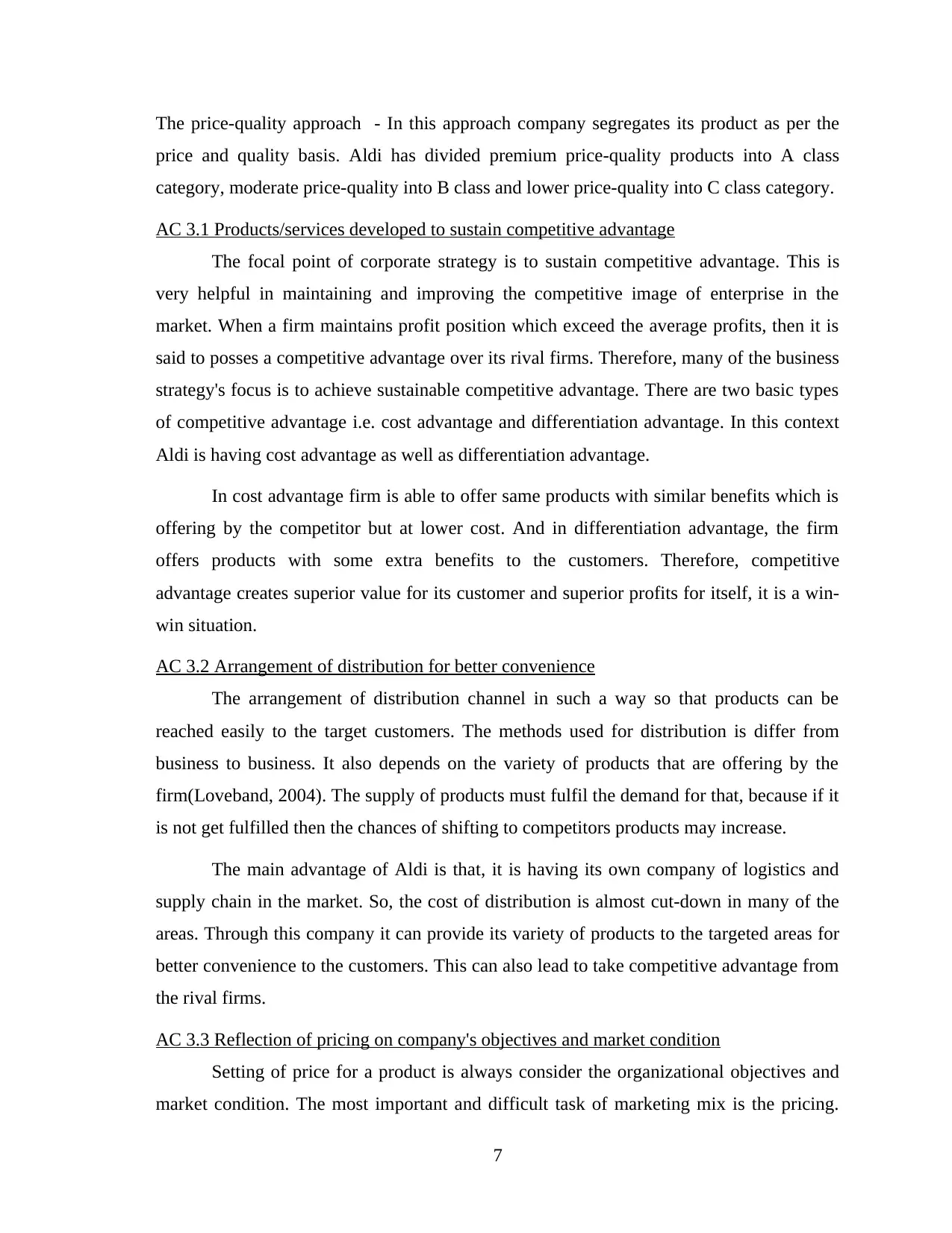
The price-quality approach - In this approach company segregates its product as per the
price and quality basis. Aldi has divided premium price-quality products into A class
category, moderate price-quality into B class and lower price-quality into C class category.
AC 3.1 Products/services developed to sustain competitive advantage
The focal point of corporate strategy is to sustain competitive advantage. This is
very helpful in maintaining and improving the competitive image of enterprise in the
market. When a firm maintains profit position which exceed the average profits, then it is
said to posses a competitive advantage over its rival firms. Therefore, many of the business
strategy's focus is to achieve sustainable competitive advantage. There are two basic types
of competitive advantage i.e. cost advantage and differentiation advantage. In this context
Aldi is having cost advantage as well as differentiation advantage.
In cost advantage firm is able to offer same products with similar benefits which is
offering by the competitor but at lower cost. And in differentiation advantage, the firm
offers products with some extra benefits to the customers. Therefore, competitive
advantage creates superior value for its customer and superior profits for itself, it is a win-
win situation.
AC 3.2 Arrangement of distribution for better convenience
The arrangement of distribution channel in such a way so that products can be
reached easily to the target customers. The methods used for distribution is differ from
business to business. It also depends on the variety of products that are offering by the
firm(Loveband, 2004). The supply of products must fulfil the demand for that, because if it
is not get fulfilled then the chances of shifting to competitors products may increase.
The main advantage of Aldi is that, it is having its own company of logistics and
supply chain in the market. So, the cost of distribution is almost cut-down in many of the
areas. Through this company it can provide its variety of products to the targeted areas for
better convenience to the customers. This can also lead to take competitive advantage from
the rival firms.
AC 3.3 Reflection of pricing on company's objectives and market condition
Setting of price for a product is always consider the organizational objectives and
market condition. The most important and difficult task of marketing mix is the pricing.
7
price and quality basis. Aldi has divided premium price-quality products into A class
category, moderate price-quality into B class and lower price-quality into C class category.
AC 3.1 Products/services developed to sustain competitive advantage
The focal point of corporate strategy is to sustain competitive advantage. This is
very helpful in maintaining and improving the competitive image of enterprise in the
market. When a firm maintains profit position which exceed the average profits, then it is
said to posses a competitive advantage over its rival firms. Therefore, many of the business
strategy's focus is to achieve sustainable competitive advantage. There are two basic types
of competitive advantage i.e. cost advantage and differentiation advantage. In this context
Aldi is having cost advantage as well as differentiation advantage.
In cost advantage firm is able to offer same products with similar benefits which is
offering by the competitor but at lower cost. And in differentiation advantage, the firm
offers products with some extra benefits to the customers. Therefore, competitive
advantage creates superior value for its customer and superior profits for itself, it is a win-
win situation.
AC 3.2 Arrangement of distribution for better convenience
The arrangement of distribution channel in such a way so that products can be
reached easily to the target customers. The methods used for distribution is differ from
business to business. It also depends on the variety of products that are offering by the
firm(Loveband, 2004). The supply of products must fulfil the demand for that, because if it
is not get fulfilled then the chances of shifting to competitors products may increase.
The main advantage of Aldi is that, it is having its own company of logistics and
supply chain in the market. So, the cost of distribution is almost cut-down in many of the
areas. Through this company it can provide its variety of products to the targeted areas for
better convenience to the customers. This can also lead to take competitive advantage from
the rival firms.
AC 3.3 Reflection of pricing on company's objectives and market condition
Setting of price for a product is always consider the organizational objectives and
market condition. The most important and difficult task of marketing mix is the pricing.
7
⊘ This is a preview!⊘
Do you want full access?
Subscribe today to unlock all pages.

Trusted by 1+ million students worldwide
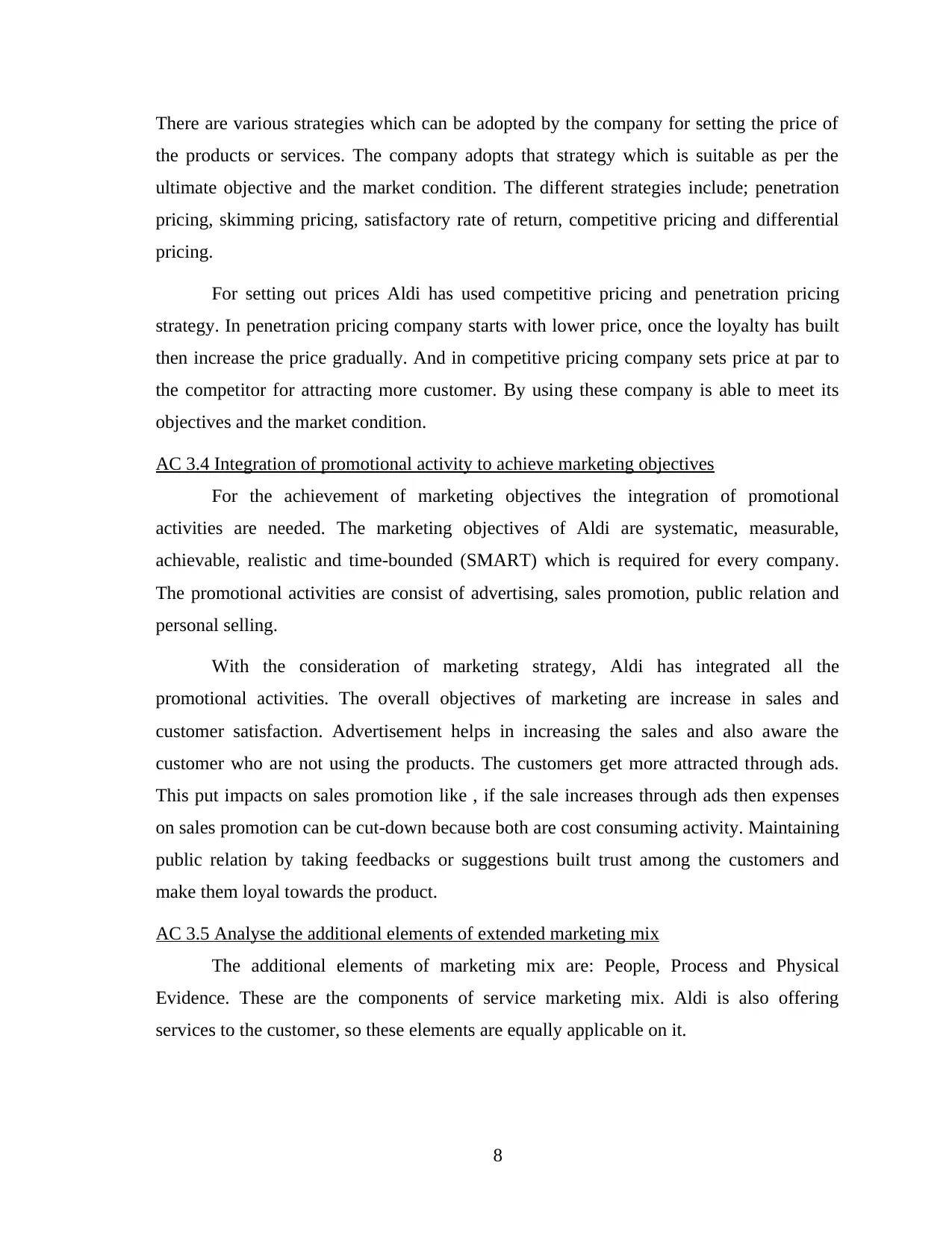
There are various strategies which can be adopted by the company for setting the price of
the products or services. The company adopts that strategy which is suitable as per the
ultimate objective and the market condition. The different strategies include; penetration
pricing, skimming pricing, satisfactory rate of return, competitive pricing and differential
pricing.
For setting out prices Aldi has used competitive pricing and penetration pricing
strategy. In penetration pricing company starts with lower price, once the loyalty has built
then increase the price gradually. And in competitive pricing company sets price at par to
the competitor for attracting more customer. By using these company is able to meet its
objectives and the market condition.
AC 3.4 Integration of promotional activity to achieve marketing objectives
For the achievement of marketing objectives the integration of promotional
activities are needed. The marketing objectives of Aldi are systematic, measurable,
achievable, realistic and time-bounded (SMART) which is required for every company.
The promotional activities are consist of advertising, sales promotion, public relation and
personal selling.
With the consideration of marketing strategy, Aldi has integrated all the
promotional activities. The overall objectives of marketing are increase in sales and
customer satisfaction. Advertisement helps in increasing the sales and also aware the
customer who are not using the products. The customers get more attracted through ads.
This put impacts on sales promotion like , if the sale increases through ads then expenses
on sales promotion can be cut-down because both are cost consuming activity. Maintaining
public relation by taking feedbacks or suggestions built trust among the customers and
make them loyal towards the product.
AC 3.5 Analyse the additional elements of extended marketing mix
The additional elements of marketing mix are: People, Process and Physical
Evidence. These are the components of service marketing mix. Aldi is also offering
services to the customer, so these elements are equally applicable on it.
8
the products or services. The company adopts that strategy which is suitable as per the
ultimate objective and the market condition. The different strategies include; penetration
pricing, skimming pricing, satisfactory rate of return, competitive pricing and differential
pricing.
For setting out prices Aldi has used competitive pricing and penetration pricing
strategy. In penetration pricing company starts with lower price, once the loyalty has built
then increase the price gradually. And in competitive pricing company sets price at par to
the competitor for attracting more customer. By using these company is able to meet its
objectives and the market condition.
AC 3.4 Integration of promotional activity to achieve marketing objectives
For the achievement of marketing objectives the integration of promotional
activities are needed. The marketing objectives of Aldi are systematic, measurable,
achievable, realistic and time-bounded (SMART) which is required for every company.
The promotional activities are consist of advertising, sales promotion, public relation and
personal selling.
With the consideration of marketing strategy, Aldi has integrated all the
promotional activities. The overall objectives of marketing are increase in sales and
customer satisfaction. Advertisement helps in increasing the sales and also aware the
customer who are not using the products. The customers get more attracted through ads.
This put impacts on sales promotion like , if the sale increases through ads then expenses
on sales promotion can be cut-down because both are cost consuming activity. Maintaining
public relation by taking feedbacks or suggestions built trust among the customers and
make them loyal towards the product.
AC 3.5 Analyse the additional elements of extended marketing mix
The additional elements of marketing mix are: People, Process and Physical
Evidence. These are the components of service marketing mix. Aldi is also offering
services to the customer, so these elements are equally applicable on it.
8
Paraphrase This Document
Need a fresh take? Get an instant paraphrase of this document with our AI Paraphraser

People – Aldi considers people (staff) who are in direct contact with the customer either for
taking their feedbacks or suggestions. It ensures to maintain focus on friendly and quick
service to the customer by their staff.
Process – The process of Aldi company is transparent and hidden, as the entire process is
not visible to its customer. It maintains standard process for each activity like billing,
availability of products etc. for every Aldi store. This creates a good image into the mind of
customers.
Physical evidence – This is the essential element of service marketing mix. This is the base
for customer's decision towards the service which they are availing(Naik, Raman and
Winer, 2005). Physical evidence of Aldi is supported by signs, symbols and artefacts of
itself.
TASK 2
AC 4.1 Marketing mix for two different market segment
Two different market segment of consumer markets on the basis of age groups can
be young people and old age people.
Marketing mix for young people – As young generation has more focused on the quality
and design of the product. They get attraction with every new product in the market. Prices
matter for them but not so much they adjust accordingly. But they always want something
new and innovative.
Marketing mix for old age people – When it comes on old age group they are very much
conscious about prices of the product. And second focus on quality. The innovated
products are not much attracted to them.
The marketing mix of company depends on the segment in which it is offering their
products and services.
AC 4.2 Difference between B2B and B2C
B2B B2C
When company is offering its products and
services to another business then it must
On the other side, when the company is
offering products and services directly to its
9
taking their feedbacks or suggestions. It ensures to maintain focus on friendly and quick
service to the customer by their staff.
Process – The process of Aldi company is transparent and hidden, as the entire process is
not visible to its customer. It maintains standard process for each activity like billing,
availability of products etc. for every Aldi store. This creates a good image into the mind of
customers.
Physical evidence – This is the essential element of service marketing mix. This is the base
for customer's decision towards the service which they are availing(Naik, Raman and
Winer, 2005). Physical evidence of Aldi is supported by signs, symbols and artefacts of
itself.
TASK 2
AC 4.1 Marketing mix for two different market segment
Two different market segment of consumer markets on the basis of age groups can
be young people and old age people.
Marketing mix for young people – As young generation has more focused on the quality
and design of the product. They get attraction with every new product in the market. Prices
matter for them but not so much they adjust accordingly. But they always want something
new and innovative.
Marketing mix for old age people – When it comes on old age group they are very much
conscious about prices of the product. And second focus on quality. The innovated
products are not much attracted to them.
The marketing mix of company depends on the segment in which it is offering their
products and services.
AC 4.2 Difference between B2B and B2C
B2B B2C
When company is offering its products and
services to another business then it must
On the other side, when the company is
offering products and services directly to its
9
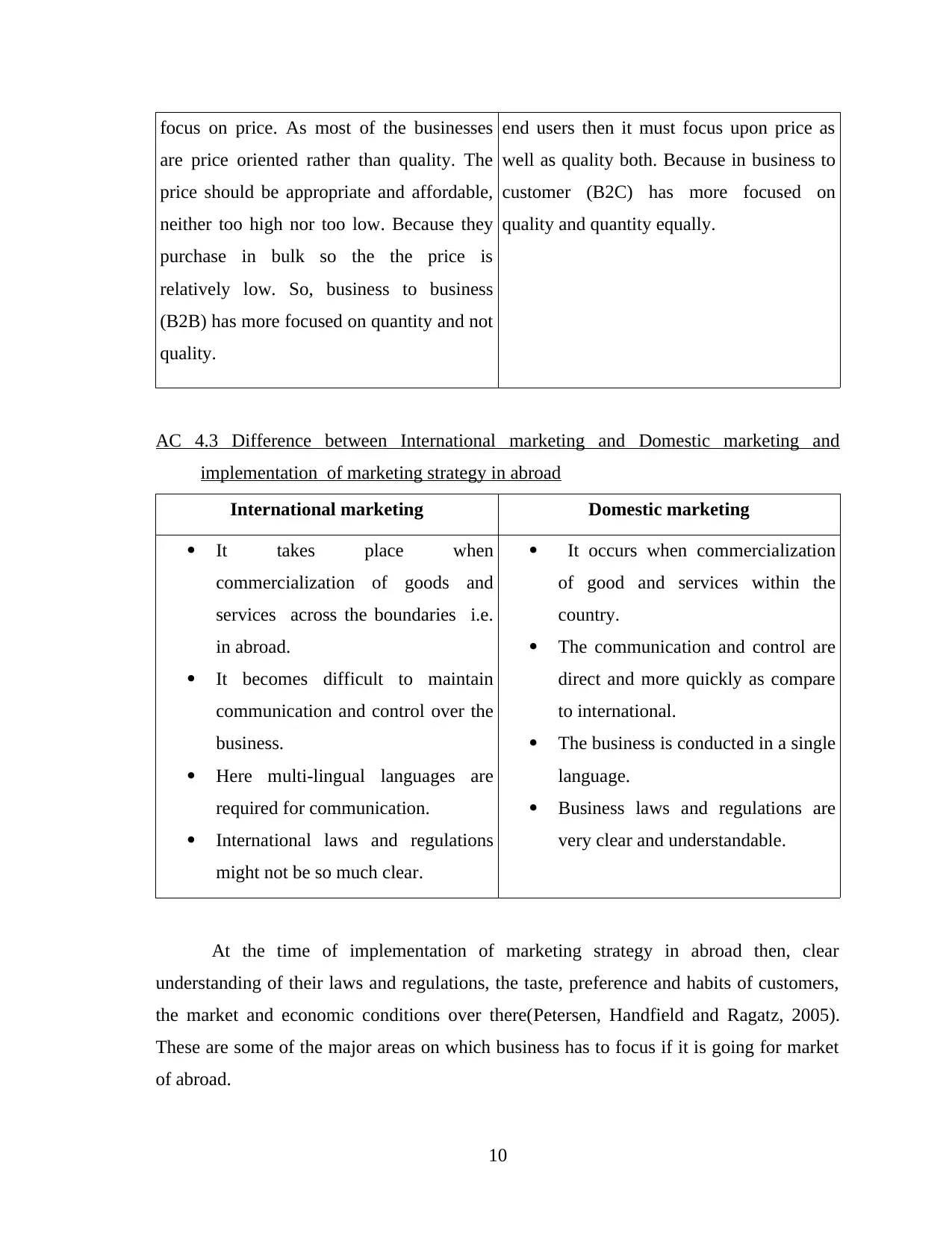
focus on price. As most of the businesses
are price oriented rather than quality. The
price should be appropriate and affordable,
neither too high nor too low. Because they
purchase in bulk so the the price is
relatively low. So, business to business
(B2B) has more focused on quantity and not
quality.
end users then it must focus upon price as
well as quality both. Because in business to
customer (B2C) has more focused on
quality and quantity equally.
AC 4.3 Difference between International marketing and Domestic marketing and
implementation of marketing strategy in abroad
International marketing Domestic marketing
It takes place when
commercialization of goods and
services across the boundaries i.e.
in abroad.
It becomes difficult to maintain
communication and control over the
business.
Here multi-lingual languages are
required for communication.
International laws and regulations
might not be so much clear.
It occurs when commercialization
of good and services within the
country.
The communication and control are
direct and more quickly as compare
to international.
The business is conducted in a single
language.
Business laws and regulations are
very clear and understandable.
At the time of implementation of marketing strategy in abroad then, clear
understanding of their laws and regulations, the taste, preference and habits of customers,
the market and economic conditions over there(Petersen, Handfield and Ragatz, 2005).
These are some of the major areas on which business has to focus if it is going for market
of abroad.
10
are price oriented rather than quality. The
price should be appropriate and affordable,
neither too high nor too low. Because they
purchase in bulk so the the price is
relatively low. So, business to business
(B2B) has more focused on quantity and not
quality.
end users then it must focus upon price as
well as quality both. Because in business to
customer (B2C) has more focused on
quality and quantity equally.
AC 4.3 Difference between International marketing and Domestic marketing and
implementation of marketing strategy in abroad
International marketing Domestic marketing
It takes place when
commercialization of goods and
services across the boundaries i.e.
in abroad.
It becomes difficult to maintain
communication and control over the
business.
Here multi-lingual languages are
required for communication.
International laws and regulations
might not be so much clear.
It occurs when commercialization
of good and services within the
country.
The communication and control are
direct and more quickly as compare
to international.
The business is conducted in a single
language.
Business laws and regulations are
very clear and understandable.
At the time of implementation of marketing strategy in abroad then, clear
understanding of their laws and regulations, the taste, preference and habits of customers,
the market and economic conditions over there(Petersen, Handfield and Ragatz, 2005).
These are some of the major areas on which business has to focus if it is going for market
of abroad.
10
⊘ This is a preview!⊘
Do you want full access?
Subscribe today to unlock all pages.

Trusted by 1+ million students worldwide
1 out of 15
Related Documents
Your All-in-One AI-Powered Toolkit for Academic Success.
+13062052269
info@desklib.com
Available 24*7 on WhatsApp / Email
![[object Object]](/_next/static/media/star-bottom.7253800d.svg)
Unlock your academic potential
Copyright © 2020–2025 A2Z Services. All Rights Reserved. Developed and managed by ZUCOL.
![Marketing Principles: A Case Study on ALDI (UK) - [Course Code]](/_next/image/?url=https%3A%2F%2Fdesklib.com%2Fmedia%2Fimages%2Ftw%2Fb396d4bd6b394a72841d1ce45968ac0c.jpg&w=256&q=75)




